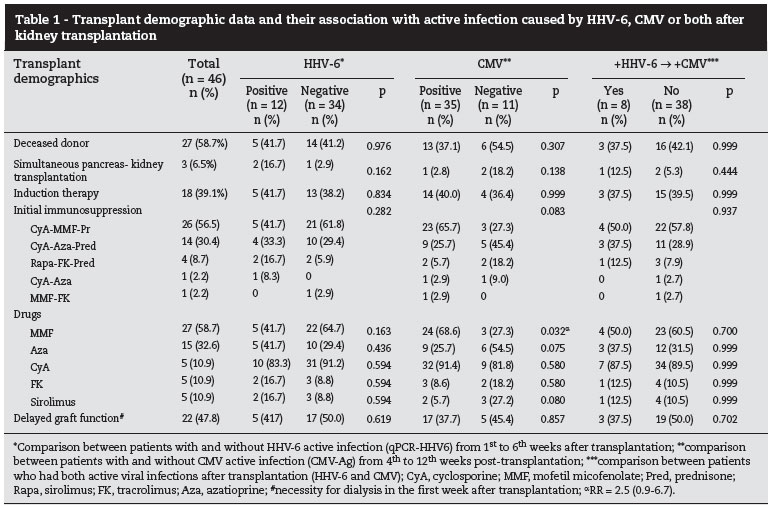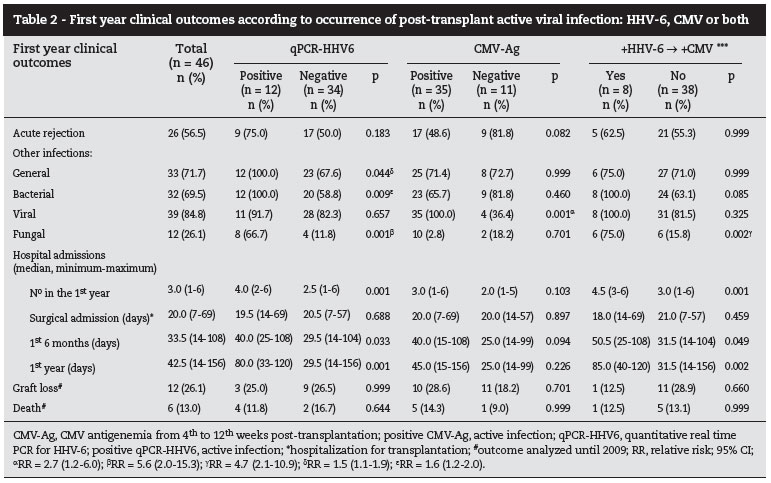Human herpesvirus type 6-(HHV-6) has been associated with morbidity after liver transplantation. OBJECTIVE: The aim of this study was to determine the HHV-6 seroprevalence among donor-recipient pairs, analyze the incidence of early active infection, its clinical manifestation, interaction with CMV, and the related morbidity in the first year after kidney transplantation. METHODS: 46 donor-recipient pairs had IgG evaluated by ELISA before transplantation: HHV-6(Pambio - USA) and CMV-(Roche - USA). A frozen whole blood sample collected weekly (from the 1st to the 6th week) was retrospectively tested for HHV-6 viral load (VL) determination by real time quantitative PCR (qPCR, Nanogen - Italy). Patients were preemptively surveyed for CMV by pp65 antigenemia (Ag, APAAP, immunohistochemistry, Biotest - Germany) from the 4th to the 12th week after transplantation. Active infection was defined as qPCR-HHV6+ (viral-load/mL-VL) and Ag+ (+cells/100.000 granulocytes), for HHV-6 and CMV, respectively. DCMV was defined as simultaneous positive antigenemia and suggestive signs/symptoms. Concerning +qPCR-HHV6, associated factors, clinical manifestation, interaction with CMV and morbidity were searched. RESULTS: Pre-transplant HHV-6 seroprevalence was significantly higher among kidney recipients compared to their donors (82.6x54.8%; p = 0.005 [3.9 (1.4-10.4)]). Active infection by this virus occurred in 26.1% (12/46), with no association with previous IgG (p = 0.412). Median VL was 125 copies/mL (53-11.264), and the median Ag was 21 +cells (2-740). There was no association between HHV-6 and CMV activation after transplantation (p = 0.441), neither concerning DCMV (p = 0.596). Median highest Ag+ and days of ganciclovir treatment were similar between qPCR-HHV6 + or - (p = 0.206 and p = 0.124, respectively). qPCR-HHV6+ was associated with higher incidence of bacterial (p = 0.009) and fungal (p = 0.001) infections, and higher number (p = 0.001) of hospital admission and longer duration of hospitalization over the first 6 and 12 months post-transplantation (p = 0.033 and p = 0.001). CONCLUSION: Latent HHV-6 infection is more common among recipients than donors before transplantation. Early active infection by this pathogen after transplantation does not increase DCMV incidence or severity during the first 3 months of follow-up. However, early HHV-6 replication is associated with other infections and hospitalizations in the first year.
Cytomegalovirus infections; Herpesvirus 6; DNA virus infections; Clinical diagnosis; Polymerase chain reaction


